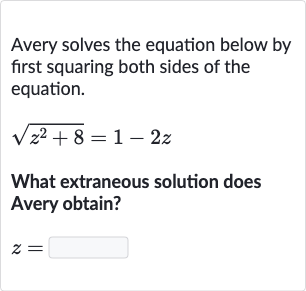Full solution
Q. Avery solves the equation below by first squaring both sides of the equation.What extraneous solution does Avery obtain?
- Rephrasing the problem: First, let's rephrase the "What extraneous solution does Avery obtain when solving the equation involving a square root by squaring both sides?"
- Squaring both sides: Avery starts with the equation . To eliminate the square root, Avery squares both sides of the equation.(\sqrt{z^\(2\) + \(8\)})^\(2 = ( - z)^
- Expanding the equation: After squaring both sides, the equation becomes:
- Rearranging the equation: Next, Avery expands the right side of the equation:
- Combining like terms: Now, Avery rearranges the equation to set it to zero:
- Using the quadratic formula: Avery combines like terms:
- Simplifying the square root: Avery uses the quadratic formula to solve for :
- Finding the solutions: Avery simplifies the square root and continues solving:This gives two solutions: and
- Checking the solutions: Avery finds the two solutions:z = and z = z = and z =
- Checking the solutions: Avery finds the two solutions: and and Avery checks both solutions by substituting them back into the original equation:For :This is not true, so is an extraneous solution.
- Checking the solutions: Avery finds the two solutions: and and Avery checks both solutions by substituting them back into the original equation:For :This is not true, so is an extraneous solution.For :This is true, so is a valid solution.

